 W
WZürich is the largest city in Switzerland and the capital of the canton of Zürich. It is located in north-central Switzerland, at the northwestern tip of Lake Zürich. As of January 2020, the municipality has 434,335 inhabitants, the urban area (agglomeration) 1.315 million (2009), and the Zürich metropolitan area 1.83 million (2011). Zürich is a hub for railways, roads, and air traffic. Both Zurich Airport and its main railway station are the largest and busiest in the country.
 W
WArt Zurich, also known as Art International Zurich and Contemporary Art Fair Zurich, is a public art fair in Zürich, Switzerland. The fair showcases contemporary art styles, including painting, sculpture, photography, graphic, video and art objects. More than 1000 exhibitors from 70 countries have participated in the art fair established in 1999.
 W
WAugustinergasse is a medieval lane that today is part of the innercity pedestrian zone of Zürich, Switzerland. It is named after the former Augustinian Abbey that is now Augustinerkirche, the former church of the convent that was disestablished in 1525. Once, it was one of the nodal points of road and public transportation between Münsterhof, St. Peterhofstatt, the present Münzplatz plaza at the former abbey, and one of the gates and fortifications of the medieval town walls. Today, as well as the Limmatquai, Augustinergasse is a section of the southern extension of the Seeuferanlage promenades that were built between 1881 and 1887, and one of the best known visitor attractions of the oldest area of the city of Zürich.
 W
WBallett Zürich, formerly known as Zürich Ballet, is the largest professional ballet company in Switzerland. Its principal venue is the Zürich Opera House and it regularly tours across the country. The company includes an ensemble cast of 36 dancers and 14 junior members. Christian Spuck has directed the company since 2012, assuming the role from Heinz Spoerli.
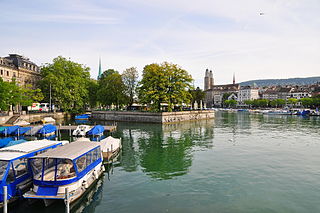 W
WBauschänzli is an artificial island, town square, and public park in Zürich, Switzerland. Bauschänzli is one of the last remains of the Baroque fortifications of Zürich which began in 1642. The neighboring Schanzengraben (moat) and the Old Botanical Garden are part of these remains. Since 1907, the island has been used as a restaurant, although it is officially a public square and park.
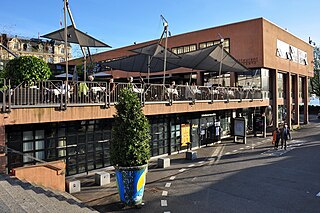 W
WThe Bernhard-Theater Zürich or Bernhard Theater is a theatre in German-speaking Switzerland situated at Sechseläutenplatz in Zürich. It is part of the building complex Opernhaus Zürich and also houses the Restaurant Belcanto. The theater was founded by and named after Rudolf Bernhard in 1941.
 W
WBürkliplatz is a town square in Zürich, Switzerland. It is named after Arnold Bürkli, and is one of nodal points of the road and public transportation, and of the lake shore promenades that were built between 1881 and 1887. The tree-shaded square between Bahnhofstrasse and Fraumünsterstrasse is called Stadthausanlage.
 W
WCabaret Voltaire was the name of an artistic nightclub in Zürich, Switzerland. It was founded by Hugo Ball, with his companion Emmy Hennings, in the back room of Holländische Meierei, Spiegelgasse 1, on February 5, 1916, as a cabaret for artistic and political purposes. Other founding members were Marcel Janco, Richard Huelsenbeck, Tristan Tzara, and Sophie Taeuber-Arp and Jean Arp.
 W
WElectronical Suicide is a four-piece Alternative Rock band made up of lead singer and bass player Diego, Guitarists Nico and Icon and drummer TomASS. They are a Switzerland based band, with all the members coming from Zürich.
 W
WEnergy was a techno-music event taking place after the Street Parade in Zürich, Switzerland. It is considered the largest indoor event of its nature in the country. In 2010, around 14,000 people attended.
 W
WFaserland is the debut novel by Christian Kracht, published in 1995. It is considered to have triggered the new wave of German pop literature. It is the swan song of the generation of the 80s, whose characteristics are so carefully described in the book that it has been called the "cult novel of a generation". Critics often compare the book to those of the American author Bret Easton Ellis.
 W
WFrauenbad Stadthausquai is a public bath in Zürich, Switzerland, forming part of the historical Seeuferanlage promenades that were built between 1881 and 1887. Situated at the Stadthausquai by the Bürkliplatz plaza, the bath was built for, and is still exclusively used by women.
 W
WHerzbaracke is a Swiss cabaret-theatre in the cantons of St. Gallen and Zürich provided on a watercraft on Zürichsee. Herzbaracke is a Swiss German language linguistic joke meaning either "heart barracks" or "heart attack".
 W
WKnabenschiessen is a traditional target shooting competition in Zürich, held on the second weekend of September each year. The festival, officially held for the first time in 1889, is one of the oldest in Switzerland, dating back to the 17th century.
 W
WLimmatquai is a street in the Swiss city of Zürich. It is named after the Limmat, and it follows the right-hand (eastern) bank of that river for about 1 kilometre (0.6 mi) through the Altstadt, or historical core, of the city. The street was once important for both road and public transportation, but today sections of it form a pedestrian zone shared with Zürich's trams, effectively forming a northern extension of the Seeuferanlage promenades that ring the shores of Lake Zürich.
 W
WLiteraturfestival Zürich is an international literary festival held annually for the duration of a week in Zurich. The main stage of the festival is located in the middle of lush nature in the Old Botanical Garden in Zurich. The Festival is jointly presented by Literaturhaus Zürich and Kaufleuten, the two major institutions for literary events in Zurich. Founder and director of the festival is Swiss conceptual artist and curator Andreas Heusser who is curating the program together with Gesa Schneider and the management team of Kaufleuten.
 W
WMünsterhof is a town square situated in the Lindenhof quarter in the historical center of Zürich, Switzerland. Münsterhof is the largest town square within the Altstadt of Zürich, and is surrounded by medieval buildings. The area forms part of the southern extension of the Quaianlagen promenades of Zürich's lakefront.
 W
WOpernhauskrawalle is the Swiss German term generally used for the youth protests at the end of May 1980 in the Swiss city of Zürich, a municipality in the Canton of Zürich. Also called Züri brännt, these events marked the 'rebirth' of the alternative youth movement in Switzerland in the 1980s.
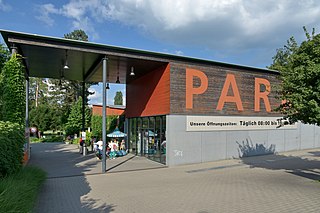 W
WPark im Grüene is a public park and a small amusement park in the municipality of Rüschlikon in Switzerland. The park area comprises the former estate of Adele and Gottlieb Duttweiler that went to public use in 1947.
 W
WPilgrim is a novel by Timothy Findley, first published by HarperFlamingo in Canada in 1999. The first US edition was published by HarperCollins in 2000. The novel is typical of Findley's interest in Jungian psychology; in fact, Carl Jung himself is a major character.
 W
WRote Fabrik is a former factory in the Wollishofen neighbourhood of Zürich, Switzerland. It is now used as a music venue and cultural centre. It is so named because the buildings are made of red brick, but also because left-wing parties were part of the campaign to turn the location into a cultural centre.
 W
WSchanzengraben is a moat and a section of the northwestern extension of the Seeuferanlage promenades that were built between 1881 and 1887 in Zürich, Switzerland. Schanzengraben is, among the adjoint Katz bastion at the Old Botanical Garden and the so-called Bauschänzli bulwark, one of the last remains of the Baroque fortifications of Zürich. The area of the moat is also an inner-city recreation area and, nevertheless, being officially a public park.
 W
WThe Schauspielhaus Zürich is one of the most prominent and important theatres in the German-speaking world. It is also known as "Pfauenbühne". The large theatre has 750 seats. The Schauspielhaus also operates three stages in the Schiffbau in the western part of Zürich, the Schiffbau/Halle, the Schiffbau/Box and the Schiffbau/Matchbox.
 W
WThe Sechseläuten is a traditional spring holiday in the Swiss city of Zürich celebrated in its current form, usually on the 3rd Monday of April, since the early 20th century.
 W
WSeebad Katzensee is a public bath in the Swiss municipalities of Zürich-Affoltern and Regensdorf.
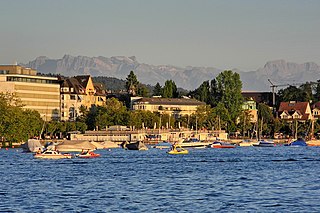 W
WSeebad Utoquai is a public bath in the Swiss municipality of Zürich, being part of the historical Seeuferanlage promenades that were built between 1881 and 1887.
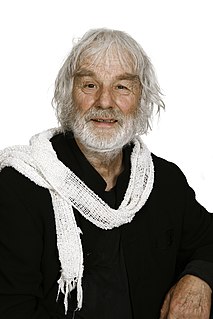 W
WErnst Sieber was a Swiss pastor and social activist who was one of the most popular and best known personalities associated with the Swiss Reformed Church. He was ordained in the Evangelical Reformed Church of the Canton of Zürich.
 W
WSmall g: a Summer Idyll (1995) is the final novel by American writer Patricia Highsmith. It was published in the United Kingdom by Bloomsbury a month after her death, after first being rejected by Knopf, her usual publisher, months earlier. It was published in the United States by W.W. Norton in 2004.
 W
WThe Confiserie Sprüngli is a Swiss luxury confectionery manufacturer founded in 1836 and internationally known for its signature macarons called "Luxemburgerli".
 W
WStrandbad Mythenquai is a public bath in the Swiss municipality of Zürich, being part of the historical Seeuferanlage promenades that were built between 1881 and 1887.
 W
WStrandbad Tiefenbrunnen is a public bath in the Swiss municipality of Zürich, being part of the historical Seeuferanlage promenades that were built between 1881 and 1887.
 W
WThe Theater am Hechtplatz is a theatre in the German-speaking Switzerland situated at Limmatquai in Zürich. Founded in 1959 as a Cabaret, it's owned and provided by the government of the city of Zürich.
 W
WThe Theater am Neumarkt or by its present official name Theater Neumarkt is a theatre in the German-speaking Switzerland situated at Neumarkt, Zürich. It is part of the building complex Bilgeriturm–Neumarkt and also houses the Hottinger guild for two days a year.
 W
WTirggel are traditional Christmas biscuits from Zürich, Switzerland. Made from flour and honey, they are thin, hard, and sweet.
 W
WThe Tonhalle-Orchester Zürich is a Swiss symphony orchestra based in Zürich. Its principal residence is the Tonhalle concert hall.
 W
WThe University of Zurich is a public research university located in the city of Zürich, Switzerland. It is the largest university in Switzerland, with its 28,000 enrolled students. It was founded in 1833 from the existing colleges of theology, law, medicine which go back to 1525, and a new faculty of philosophy.
 W
WZentralbibliothek Zürich is the main library of both the city and the University of Zurich, housed in the Predigerkloster, the former Black Friars' abbey, in the old town's Rathaus quarter. It was founded in 1914 by a merger of the former cantonal and city libraries. Its history ultimately goes back to the Stiftsbibliothek of the Grossmünster abbey, first attested in 1259. Much of the abbey's library was lost in the Swiss Reformation, especially in an incident of book burning on 14 September 1525, reducing it to a total inventory of 470 volumes. From 1532, Konrad Pellikan (1478–1556) began rebuilding the Stiftsbibliothek, especially with the purchase of Zwingli's private library, and the library catalogue in 1551 lists 770 volumes. The city library had been established in 1634, and its policy to allow access only to citizens of Zurich led to disputes with the University, which led to the establishment of a cantonal library in 1835, built from some 3,500 volumes with 14,000 titles of the Stiftsbibliothek, some 340 volumes of the recent University Library and some 1,700 volumes of the Gymnasiumsbibliothek.
 W
WZunft zum Kämbel is a Zunft (guild) organisation in Zürich, Switzerland. The guild was established in 1336; their guild house, the Haus zur Haue building, is situated at the Limmatquai.
 W
WZürich German is the High Alemannic dialect spoken in the Canton of Zürich, Switzerland. Its area covers most of the canton, with the exception of the parts north of the Thur and the Rhine, which belong to the areal of the northeastern Swiss dialects.
 W
WThe Synagoge Zürich Löwenstrasse is the oldest and largest synagogue in the Swiss municipality of Zürich. In 1884 built in Moorish style, the oldest synagogue of Zürich also houses the prayer and school house of Israelitische Cultusgemeinde Zürich (ICZ) which was founded in 1862. ICZ is a unified Jewish community having about 2,500 members, and thus the largest Jewish community in Switzerland, which since 2007 in the Canton of Zürich is recognized as a denomination, i.e. it has the same legal state as the Christian denominations. In the synagogue, the community celebrates the daily Minyan and Shabbat and holiday services. The synagogue is a cultural heritage of national importance in Switzerland.